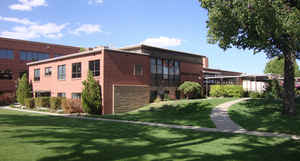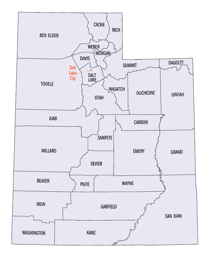Utah Counties
There are twenty-nine counties in the State of Utah. There were originally seven counties established under the provisional State of Deseret in 1849: Davis, Iron, Sanpete, Salt Lake, Tooele, Utah, and Weber. The Territory of Utah was created in 1851 with the first territorial legislature meeting from 1851-1852. The first legislature re-created the original counties from the State of Deseret under territorial law as well as establishing three additional counties: Juab, Millard, and Washington. All other counties were established between 1854 and 1894 by the Utah Territorial Legislature under territorial law except for the last two counties formed, Daggett and Duchesne.Uintah County, Utah
Uintah County Education, Geography, and History

Uintah County is a county located in the state of Utah. Based on the 2010 census, the population was 32,588.Its county seat and largest city
is Vernal. The county was named for the portion of the Ute Indian tribe that lived in the basin.
Uintah County is the largest natural gas producer in Utah, with 272 billion cubic feet produced in 2008.
The Vernal, UT Micropolitan Statistical Area includes all of Uintah County.
Etymology - Origin of Uintah County Name
after the Uinta-Ats Utes
Demographics:
County QuickFacts: CensusBureau Quick Facts
Uintah County History
Uintah County is located in the
central portion of the Uinta Basin, part of which extends 60 miles into western
Colorado. The northern rim of the Basin is formed by the Uinta Mountains, the
western rim by the Wasatch Mountains, and the southern rim by the Roan and Book
cliffs. The Basin is the geographical remains of prehistoric Uinta Lake, formed
during the late Tertiary period, the same period when sediment was deposited in
the lake bottom to form gilsonite, oil shale, tar sands, and oil. Ashley Creek
and the White, Uinta, and Green rivers are the major streams in the county. The
Green, the largest of the four, slices through the central portion of the
county.
Prehistoric Indian sites suggest that the Uinta Basin was inhabited thousands of
years ago by Archaic and the later Fremont peoples. In historic times it was
part of the Utes' domain. The first white men in the area were Fathers Dominguez
and Escalante who traveled through the Uinta Basin in 1776 searching for a land
route to Monterey, California. In his diary, Escalante called the Basin ". . . a
fine plain abounding in pasturage and fertile, arable land, provided it were
irrigated . . ." Nearly 50 years later American and French trappers found the
Basin rich in beaver and other wildlife. In 1831-32 Antoine Robidoux, a French
trapper licensed by the Mexican government (Utah was part of Mexico until 1848),
built a small trading post near present-day Whiterocks where trappers could
trade beaver pelts for supplies. The post was abandoned in 1844 because of
difficulties with the Indians.
In 1861 Brigham Young sent a small party to explore the Basin for possible
settlement. They reported "that all that section of country lying between the
Wasatch Mountains and the eastern boundary of the territory, and south of Green
River country, was one vast contiguity of waste and measurably valueless. ..."
So Young decided not to send settlers there.
That same year President Abraham Lincoln created the Uintah Indian Reservation,
thus beginning the relocation of many Utah and Colorado Indians to the Uinta
Basin. In the 1880s the Uncompahgre Reservation (now part of the Uintah and
Ouray Reservation) was created in the southern portion of Uintah County. Ashley
Valley was not part of either reservation, and by 1880 enough ranchers and
farmers had settled there that the territorial legislature created Uintah
County, taking most of the land from Wasatch County. The county seat, originally
in Ashley, was later moved to the larger community of Vernal. With the building
of irrigation canals other towns were founded, including Jensen, Maeser, and
Tridell.
In about 1888 gilsonite was discovered in various parts of the county and on the
eastern portion of the Uncompahgre and Uintah reservations. Miners quickly
persuaded the federal government to withdraw 7,000 acres from the Uintah
Reservation so that they could legally mine gilsonite. This area, called "The
Strip", for a time lacked any law and order.
Uintah County's economy rests on farming, ranching, and extraction of oil and
gas. It is increasingly influenced by world energy prices.
*Source: Beehive History 14: Utah Counties. 1988. Utah State Historical Society,
300 Rio Grande, Salt Lake City, UT 84101-1182.
Geography: Land and Water
As reported by the Census Bureau, the county has a total area of 4,499 square miles (11,652 km2), of which,
4,477 square miles (11,596 km2) of it is land and 22 square miles (57 km2) of it (0.48%) is water.
Neighboring Counties
Bordering counties are as follows:
- Daggett County, Utah - (north)
- Moffat County, Colorado (northeast)
- Rio Blanco County, Colorado - (east)
- Garfield County, Colorado - (southeast)
- Grand County, Utah - (south)
- Emery County, Utah - (southwest)
- Carbon County, Utah - (west)
- Duchesne County, Utah - (west)
- Summit County, Utah - (northwest)
Education







